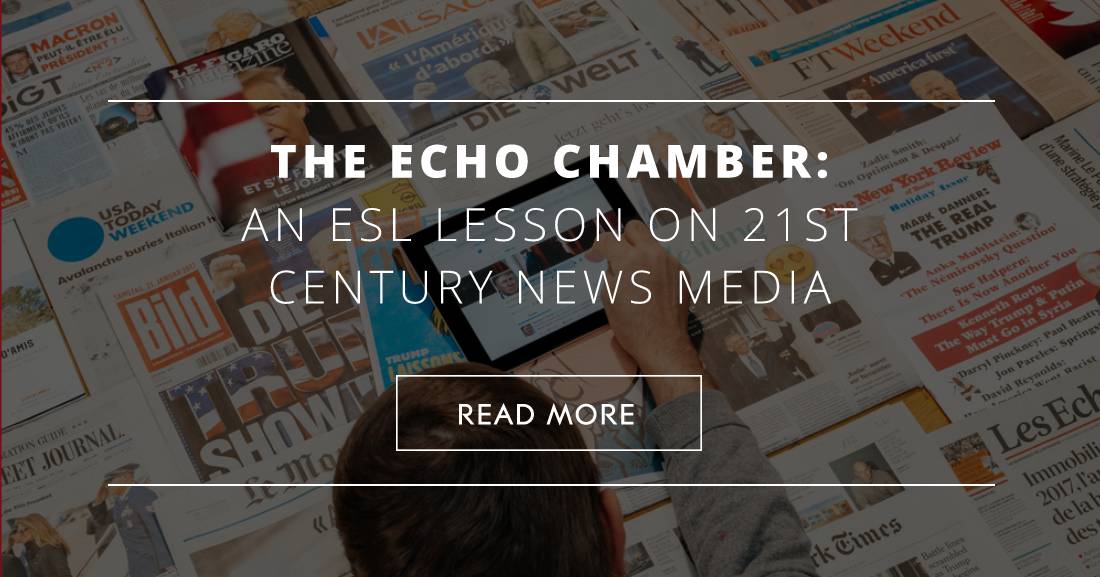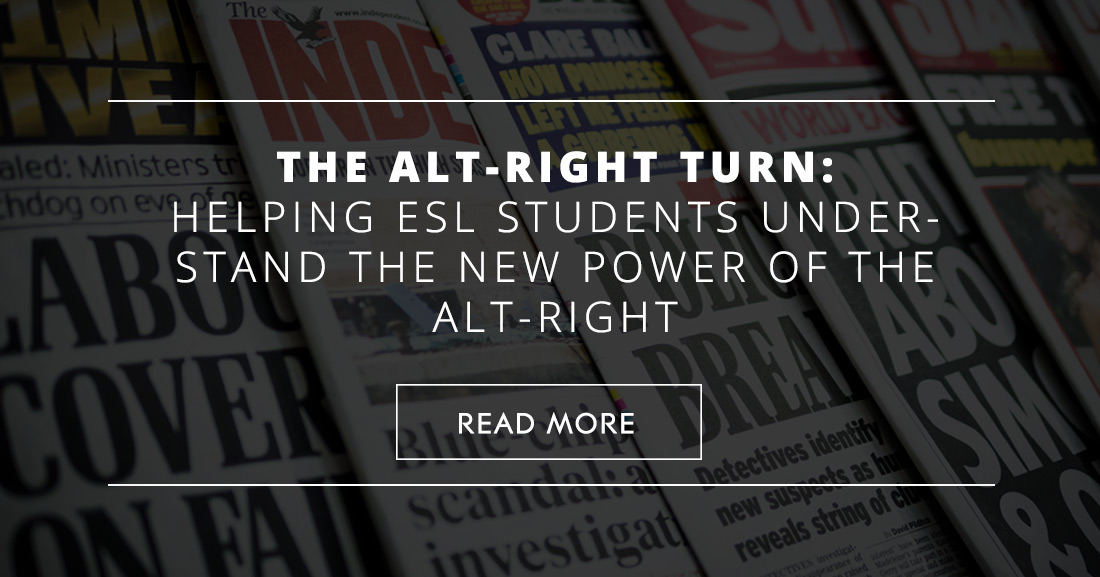The Echo Chamber: An ESL Lesson on 21st Century News Media


Instead of reading my usual news sources with breakfast, I tried out the advice of a friend who told me that the best way to understand those with whom you profoundly disagree is to read their newspapers. So, I spent an hour reading the Alt-Right online press, trying to tease out the ideology which lies behind the headlines, and slowly figuring out to whom they’re trying to appeal, and why.
This is a challenging thing to do. It means leaving your echo chamber and exposing yourself to views which might run entirely counter to your own. But that strange and confusing hour of reading taught me a great deal. In particular, I learned that a new and powerful political force is now at work in the United States, one which has been emboldened as never before by the election of Donald Trump and the new wave of anti-establishment, conservative feeling surrounding the November 2016 election.
My students were aware that right-wing and racist forms of media had exploded in popularity in 2016, and we tried firstly to define who these people are, and why their writings and speeches were gaining so much attention. We found that there is no single organization which provides structure to the American right; even the KKK is now organized into local chapters, without an overarching leadership. We briefly researched a number of these organizations, focusing on those which were flagged by watchdogs such as the Southern Poverty Law Center and the Anti-Defamation League (two groups your students should become briefly familiar with).
We immediately found that ‘Alt-‘ as a prefix was pretty interesting in itself. More than one student wondered whether its use was related to computing (consider ‘alt-F10’ and similar software commands) but we agreed that it was simply short for ‘alternative’, and that ‘alt-right’ expressed a family of non-traditional conservative views centered around the following core beliefs, which were virtually ubiquitous among right-wing groups:
A focus on appealing to the ‘common man’, generally identified as people (of both genders, but chiefly men) who were white, working class and who did not have a college degree.
We found a widespread sense that government (often disparagingly described as ‘big government’, which is seen as a cumbersome, burdensome, undemocratic and inefficient mechanism) was primarily concerned with elevating the middle- and upper-classes, and that the working class was being left behind. This created a strong antagonism between the ‘haves’ and ‘have-nots’, with the former dominating politics and the economy, leaving the latter to fend for themselves.
A large majority of articles in the right-wing media focus on race relations, and it was here that we first hit on a major theme of alt-right media coverage: the stories are cherry-picked and then given a deliberate editorial slant so that the story contributes to strengthening a pre-existing narrative. These narratives are centered around stereotypes which willfully generalize about millions of people (“Mexicans are drug-dealing criminals”, “Jews are conniving and greedy”, “African-Americans are predisposed to crime”, etc). We found countless examples of this kind of ‘journalism’, where the point was not to present facts, but to bolster a pre-determined racist viewpoint.
We also spotted more than one article which appeared to push an anti-miscegenation agenda, i.e. it claimed that different races should not inter-marry. I made the point to my students that the very slow repeal of the Jim Crow laws in the south meant that, as recently as the 1950s, inter-racial marriage was legally prohibited in some states.
The briefest glance at alt-right coverage of Hillary Clinton’s presidential campaign will reveal thinly veiled sexism. Women are portrayed as weaker than men, unable to perform the same roles, and subject to hormonal and other emotional issues which render them unfit for the presidency. My students remained horrified throughout our readings, but these unscientific, generalistic and roundly offensive assertions made them angrier than any other.
My students found that White Supremacy was expressed relatively subtly in these articles, more through their repeated assertions that other races were defective in some way, than through examples of white achievement or innate superiority. Still, we found a pervasive sense that only white people could be trusted to govern or lead, and that white Americans could claim some form of originality or authenticity rooted in an ‘Anglo-Saxon’ ethnicity. I was pleased to see that my students noticed the omission of Native Americans, or the huge diversity of people who emigrated to the US in the 18th and 19th centuries. I taught the word revisionism and reminded my students that history is sometimes written merely by those who shout the loudest.
We charted an explosion in anti-Jewish sentiment during 2016, with articles accusing prominent Jews of corruption and fraud, or accusing a secretive, nameless Jewish cabal of running the world economy for their own gain. My students were familiar with these assertions and rightly rubbished them, tracing a connection with other right-wing organizations who seized upon the Jews as a scapegoat during difficult economic times; this was our first overt comparison with the rise of the Nazi party in Germany in the 1930s.
This is best defined as a style of discourse and behavior which tries to avoid causing offense, but it has become a punching bag for the alt-right, who view PC sensitivities as unnecessary, as a threat to white power, and as an encouragement to multi-culturalism, which many on the American right regard as a failed experiment or as a national shame. We took a quick look at the language of political correctness and noted that PC behavior seems to occur alongside a greater use of empathy, and an increased willingness to engage with, and understand, people from different backgrounds. We also noted that a social prohibition on using offensive language inevitably took power away from racist groups who used these emotive and upsetting words to denigrate and belittle other ethnic groups.
My students quickly found that the right-wing and news fakery seem to co-exist in a symbiotic relationship. Even if not completely fake, many of the stories on Breitbart and other alt-right news sources presented their facts (such as they were) in so radically skewed a manner as to render the news source unusable by readers in search of reliable information. Instead, we returned to the idea that a pre-existing narrative was driving these stories, and once we included that concept, the notion of fake news made more sense; these stories were intended purely to rile people up, to leave them more convinced of what they already believed, and to instill in them a fear of change in American society.
We couldn’t resist including a rather fascinating cultural phenomenon invented by a pair of stoner comedians: the cheerful, nostalgic ‘member berries’ from South Park. If you’ve yet to experience them, and even if you’re not a fan of Stan, Kyle, Cartman and friends, please give them a try. My students and I couldn’t think of another comedic metaphor which hit the nail so precisely on the head. Charming to the point of being addictive, member berries simply spout reminiscences of cultural and political highlights, all dating from a hazy past in which none of our current social or economic problems existed. (I chose not to side-step the connotations implicit in the little berries’ name, as my students are all 16+ and I know them quite well. Hilarity ensued.)
It emerges (spoiler alert) that they are agents of the Trump Campaign (either wittingly, or otherwise, we’re never quite sure) and are deliberately fostering an upwelling of nostalgia so that voters will choose a candidate who promises a return to better times. Think what you will of Parker and Stone, but more than one of my students called the cute bunches of member berries a ‘genius’ idea.
We took a look at other right-wing parties past and present, and found important areas of commonality in the circumstances of their growth and success. Again, we heard echoes of the 1930s, and were able to tease out these main drivers for the spread of right-wing populism:
The KKK and the right-wing in general find greater relevance (and therefore recruiting success) during periods of economic uncertainty. The wholesale shift of manufacturing jobs away from the American ‘rust belt’ and mid-west has left suspicion, conspiracy theories, resentment and despair in its wake. Hitler, too, found post-Weimar Germany to be a fertile recruiting ground, with its hyper-inflation and massed unemployment, as well as the crippling financial reparations forced upon Germany by the Versailles treaty which ended the First World War in 1918. Blame and anger followed, focusing on the usual range of scapegoats (foreign powers, Jews, ‘social undesirables’, etc), and the rest is history.
If we briefly study the achievements of Congress in the years 2008-16, the story will be one of stagnation, gridlock and frustration. These sessions of congress enacted fewer new laws than almost any since the 1970s, due largely to focused and unyielding obstructionism by Republican lawmakers who occupy a majority of seats in both houses. This tactic appears to have been successful in undermining confidence not only in the President, but in the democratic process itself. A legislative branch which rarely legislates is hardly a gleaming advertisement for the promise of democracy.
Many voters were also concerned that their opinion would never truly count, as their representatives are too close to business interests who bankroll their campaigns. This sense of disillusioned, disenfranchised hopelessness is a powerful motivator for right-wing sentiments; the current system has failed, they argue, and we now need candidates (such as Donald Trump) who are not part of the ‘establishment’ and who might offer something new.
The Alt-Right has encouraged its readers to apportion blame for their lot, and it generally falls on the establishment, democrat politicians and the ‘one-percent’. They are painted as self-interested, inept and corrupt, an allegation Trump leveled numerous times at his democratic opponent. But some alt-right sites go further and blame Mexico, China, Judaism, the EU, pluralism and multi-culturalism for unwelcome changes in US society and for the economic pressures which have brought such despair to the heartland.
Mistrust and racism lead to the drawing of boundaries, and in the case of the alt-right, these lines of demarcation become hardened and impermeable. A strict ‘us and them’ approach, coupled with blame and resentment of foreigners and umbrella institutions such as the UN, EU and NATO, leads to a blinkered, provincial mindset. Old ways of doing things (whether or not they are inherently racist) are elevated and celebrated, partly through nostalgia for a ‘better’ time when the world seemed larger and was less intimately connected. This is summed up well in an old aphorism from Yorkshire, where I grew up, which I passed onto my students:
There’s none I trust except me and thee, and I’m not too sure about thee.
Here, thankfully, I found no real need to do so; my students arrived at this topic with a wariness of the alt-right, and became worried that this powerful new force is based on little more than fakery, hatred and fear. However, my students also recognized that the alt-right has become a political force in American life, and that its continued growth was something we should all watch with care, and not a little concern.